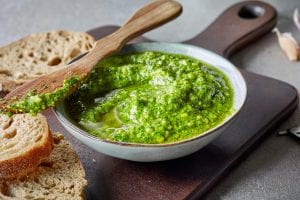There are many different types of basil offering unique subtleties that are best when used in specific flavor combinations. Two of the most popular varieties of basil are Sweet Basil and Thai Basil. While they are both basil and both feature many common properties, they also differ in a few key ways. Let’s take a look at Thai Basil vs Sweet Basil, examining the unique qualities of each and when you may wish to use one of these popular types of basil over the other.
Thai Basil
Thai Basil has the traditional basil sweetness, but it’s also spicier than most basil varieties. It has strong notes of anise that really stand out when added to recipes, even when it’s cooked down at extremely high temperatures. The anise will add a slight black licorice flavor to your cooking that might not fit well with all dishes but can really do a lot to bring the right dish together, such as many Thai-style dishes, hence the name. This spicy anise flavor and the fact that it remains strong even after thorough cooking is really what makes Thai Basil stand out over other basil varieties, especially Sweet Basil. You have likely tasted this unique flavor in many Indian, Vietnamese, and, especially, Thai dishes at your favorite restaurants.
Whereas Thai Basil wouldn’t work so well in Italian foods, the spiciness and strong flavor of the Thai Basil are really the glues that hold many of your favorite exotic dishes together. If you are making a homemade curry or Asian stir-fry, picking up some fresh Thai Basil at the store will add the perfect flavor, providing some authenticity to your dishes. It is also great for soups, topping off noodle dishes, and sprinkling on salads. You won’t need to worry too much about when you add it to your recipe or at how high of a temperature it’s being cooked at as the flavor should retain even under extreme duress. This is a spicy and hearty basil variety that stands out.
Sweet Basil
Sweet Basil is, well, predominantly just sweet with only a very light herbal spiciness that resembles more than anything the taste of cloves. It is also mild and doesn’t stand out too much when utilized in dishes. This type of basil is most commonly used in Italian foods and offers a subtle earthiness and herbal sweetness to dishes that help round out the flavors with some complex but slightly subdued notes. If basil is being used in your favorite pasta sauce, it is likely Sweet Basil. Therefore, finding some Sweet Basil when making your own homemade pasta sauce is definitely the way to go if you want that authentic Italian flavor. Sweet Basil is fantastic in tomato sauces and pesto and can add a lightly sweet and spicy tang to salads.
One thing to note about Sweet Basil is that it doesn’t hold-up under extremely high temperatures nearly as well as Thai Basil, so you are going to want to utilize this in dishes generally only with light sauteeing and no heavy heat. Sweet Basil is often one of the last ingredients to be added into the recipe because of this, so keep this in mind when playing around with Sweet Basil in the kitchen.




